Red roses: varieties and rules of care

Red roses are a real classic. Some varieties delight with their frost resistance, others with beautiful and abundant flowering, others are capable of creating sweeping bushes. Gardeners are very fond of varieties that can climb a vertical wall for several meters, as they help to create unique objects in landscape design.
Peculiarities
Red roses in the garden are immediately striking, because they have a bright, rich color. No wonder they are considered one of the best for creating romantic bouquets. Breeders have bred many species of this flower, the buds of which differ in shape, color intensity and size. There are flowers with a delicate, scarlet hue, and the intensity of the color of some varieties reaches burgundy. Sensual and exhilarating, red roses conquer the hearts of gardeners.
Breeders managed to obtain most of the varieties by repeated crossing and subsequent selection. Some of the varieties of roses are domesticated species of wild plants.



The best varieties and their characteristics
In nature, there are almost no deep red shades of roses, many have been bred by breeders for decades. These include varieties of hybrid tea plants, floribundas and English roses. A list of the most prominent varieties is presented below.
- "Crimson Shower" - shows bunches of small, crimson-red flowers from mid-summer. The plant keeps in large clusters in inflorescences. The foliage is dark and shiny. The bush pleases with flowering until September.
- The Prince's Confidence - a rose with bright, red flowers. It belongs to varieties that can weave along vertical surfaces. During the flowering period, clusters of crimson-red buds with beautiful, velvety petals appear. The bush has shiny glossy foliage and a light aroma.
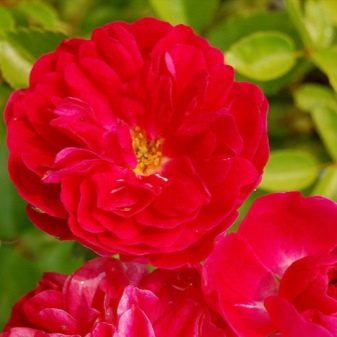
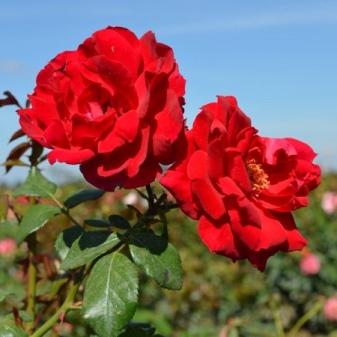
- "Scarlet Glory" - a curly rose with a large bud of a dark crimson color, on which a purple tint appears over time. Flowering begins in early summer, the buds are abundant on the bush. Will delight the plant with a rich aroma. The rose was bred in 1935.
- Peter Pan - a rose that was bred in 1998. It is a deep red hybrid tea flower with tiny glossy foliage.
- "L. D. Braithwaite " - English rose with large flowers that appear on the bush during the entire flowering period. It is the brightest of all English roses with a light crimson color. The petals are loosely arranged, forming beautiful, large inflorescences. The result is a fluffy, rather spreading shrub.
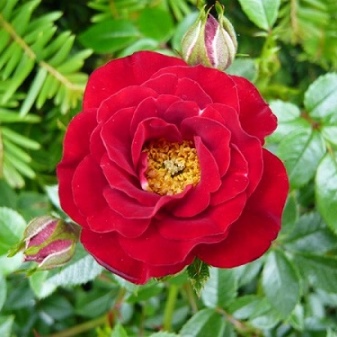
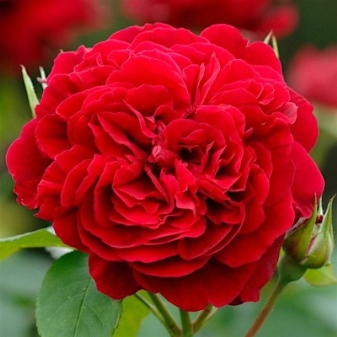
- Manstead Wood - a rose that has won many awards. It is a bushy variety with velvety, raspberry-colored flowers with lighter outer petals. Large flowers degenerate over time into smaller ones. A strong aroma emanates from the bush.
- Royal William - hybrid tea rose, with a wonderful aroma and classically pointed, crimson flowers. The buds have a velvety red color and rich aroma. The shrub grows rather quickly.
- "Violetta" - has small, cropped, crimson-purple flowers with yellow stamens. The spreading bush can please with a light, fruity aroma.


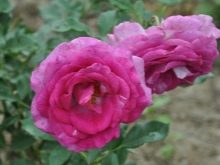
- "Alec Red" - a rose, which is characterized by the presence of many large petals in the bud.Shade of cherry red. The plant has a strong aroma, blooms several times during the season.
- "Alexander" - is appreciated for its very bright, long-lasting flowers. The variety belongs to hybrid tea, therefore it grows quickly, demonstrates excellent resistance to temperature extremes, and can grow in shady areas. The rose was first bred in 1972.
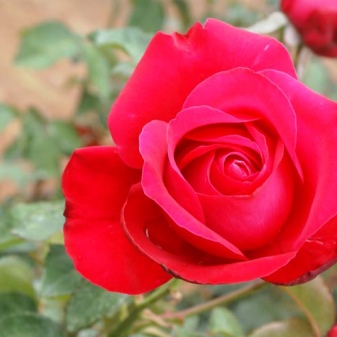
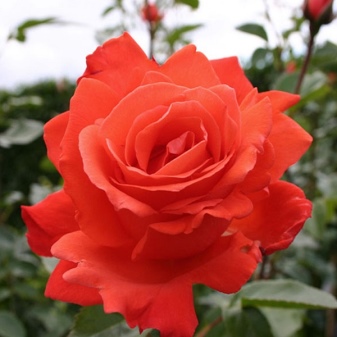
- Allen Chandler - famous for its large, semi-double flowers with a special shine and bright color, which is closer to crimson. Opening up, the flower reveals golden stamens. The shrub blooms profusely early in the season and then several more times over the summer.
- "Spray" - this is not a small-flowered rose, on the contrary, it is popular for its large flowers and their deep pink hue.
The description says that the maximum height of the bushes is one meter. Despite the abundance of flowers, the bush does not smell at all.
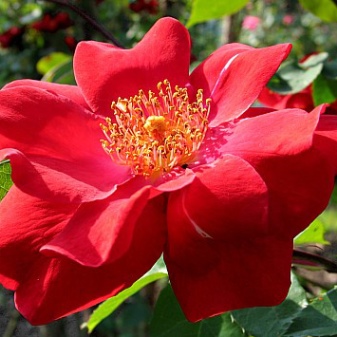
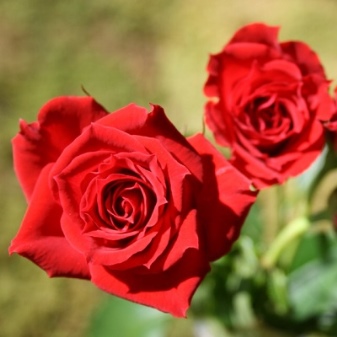
Landing rules
There are certain rules for planting rose seedlings, and if they are not followed, it will be quite difficult to get healthy bushes. Cutting or grafting is carried out at the time strictly specified by professionals, otherwise an adult plant may die. Roses grow best in good sunlight. If it is impossible to find a place where the sun's rays fall all day, then it is worth finding a site where they are in the morning, since the morning sun helps to quickly dry the leaves. The morning sun rays are an excellent prevention of diseases. But the afternoon sun in the middle of summer can burn the petals.
Roses do not tolerate damp soil. If well-drained areas are not available, then consider planting in an elevated position or install drainage separately. The roots of most varieties do not compete with the trees and shrubs planted nearby. But the best results can be achieved by growing flowers in flower beds. It is advisable to periodically feed them with fertilizers and water them with water to replenish the amount of elements consumed by other plants. It is very important to know that the root system of roses does not compete well with the roots of the lawn grass, so it should not grow near their base.

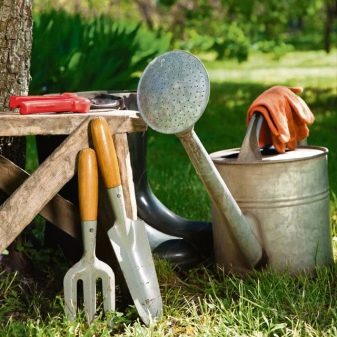
Selection and storage of seedlings
Roses are usually sold when they are biennial, after being grown outdoors, if an adult plant with flowers is purchased. They are sorted according to size. The largest is the first variety, and each subsequent one has flowers of a smaller diameter. Roses can be sold with an open root system in local nurseries. You can also order by mail. When choosing plants in the store, make sure the stems are dense and green with smooth, unpeeled bark. It is important to consider the roots - preference should be given to the planting material in which the root system is well balanced. A dead rose has less weight, and the branches are brittle.
It is worth remembering that sleeping roses sold for sale in stores soon begin premature, weak growth in a warm room. Over the course of several weeks, this can weaken or even kill the plant. After purchase and immediately before planting, it is worth immersing the roots of such planting material in water.
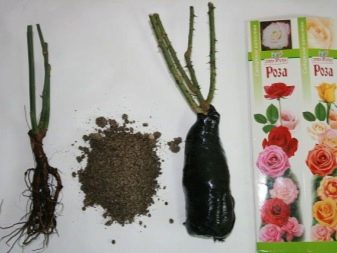
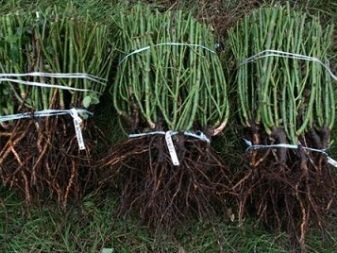
Container plants can be purchased and planted at virtually any time during the growing season. Sometimes they are sold already with flowers, when planting, the inflorescences will not be discarded, the process will continue as expected. Such plants should always be in a large container, since their root system grows quite well at the time of sale. If you plan to plant on the same day or the next, soak the roots for several hours or overnight in water, if not, then you can dry the rose slightly before storing it. They are kept in water for no more than 24 hours, otherwise the seedling can be damaged.
You can moisten the packaging material and put it in a cool place where the shrubbery cannot freeze.In this form, roses can be stored for 2-3 additional days. If you need to hold it longer, then it is worth taking the roots out into the open air. Roses are placed in a shallow trench and the roots are covered with soil. If the tops are dry, it is helpful to place the entire plant in a trench and cover both the top and roots with earth before planting.


Disembarkation time and place
In order for the bushes to grow, it is necessary to clearly determine the time and place of their planting. The optimal landing time depends on the climatic characteristics of the region. Where the temperature does not drop below -10 degrees Fahrenheit, either in the fall or spring, it is worth planting. If the grower lives in an area where the temperature drops below this mark, spring planting is preferable. Plants are planted in the ground when they are dormant if purchased bare-root, but container-grown roses can be planted throughout the growing season.
The distance between the bushes may depend on the temperature. In areas with harsh winters, it is better if planting is done more often; in mild climates, you can plant bushes further apart. The root of the rose needs to be trimmed slightly before planting to remove broken ends. After purchase, the plant is immediately unpacked.

When the roses are ready to plant, you need to make sure the roots are not dry and the hole is properly prepared. The soil or bed should be prepared from fall or early spring if time and weather conditions permit. It is advisable that the soil is treated at least 4-6 weeks before the roses are planted.
First you need to dig a hole in the ground. Its width and depth should be such that the root system can be completely submerged. The conical shape of the hole allows the fertile layer to be laid in the center of the hole. After laying the bush, the hole is covered with fertile soil, which is mixed with mulch, fertilizers. The head is necessarily hidden under the embankment. After that, a thorough compaction and watering is performed.


The planting depth of modern hybrid roses is determined by the point where the root system and trunk meet. If this joint is injured by frost, then the entire top may die and new branches will begin to grow from the root, but the plant may differ from the original version. That is why it is so important that this particular element is located slightly below the soil level. In the northern regions, it is a few centimeters underground.
After the hole has been dug, it will need to be sprinkled about half with good fertile soil. The tapered shape eliminates air pockets. The plant is removed from the container along with the roots and soil, this should be done very carefully. If the root system is too large, you should not cut it off, you just need to dig a larger hole. After backfilling, a small mound should form. The plant should be watered and sprinkled with mulch on the ground so that the moisture remains for as long as possible. When planting woven roses, they are immediately tied to stakes or supports.

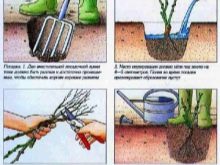

How to reproduce?
Propagation by cuttings is by far the most common method for roses. However, even under optimal conditions, 90% success is considered an excellent result. The fact is that cuttings do not have enough root system to absorb water and nutrients. Thus, in order to successfully propagate rose bushes, it is required for the grower to create an environment that will support the growths until they develop enough roots to survive on their own. The best time to take cuttings from plants is early summer. Stems that are not quite young, but also not mature with wilting flowers, fit perfectly. A twig with a bud is too young to reproduce.
The process begins by filling a clean container with a good fertile mixture.It should contain a sufficient amount of organic compounds useful to the plant. Before planting the cuttings, the soil is watered, but it should not be too wet, otherwise the rose will simply rot. Select cuttings that are healthy and representative. They are always taken from the top and from the side. Cuttings taken from the middle of the plant do not take root, which remains a mystery to gardeners.


Choose a stem 4 to 6 centimeters long with 2 or 3 leaves. It is they who produce sugar from photosynthesis and hormones that promote rooting. Use a razor blade or sharp pruning shears to make a clean cut at a 45 degree angle. It is this angle that promotes rapid rooting.
In the next step, flowers or buds are removed, as well as the lower leaves. Cut the remaining leaves in half to reduce moisture loss through transpiration. Using a pencil, make a small hole in the ground, immerse the handle. Cover the top of the seedling with a glass jar or the entire container with a plastic bag to create a greenhouse effect and maintain a high level of humidity. Roses root best in bright light. For this reason, they put containers on the window, but overheating of the cuttings should be avoided. After 3 or 4 weeks, the first roots will appear.
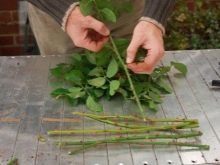
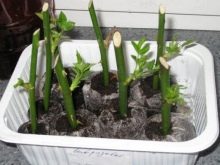
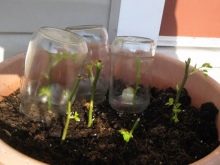
How to care?
The main care of roses is the timely introduction of top dressing, high-quality watering, and sometimes pruning. If you do everything on time, then the garden with roses will become large and beautiful, it will delight with its aroma and colors from spring to late autumn.
Top dressing
Most varieties are quite tolerant of the soil type. However, shrubs grow fastest on relatively fertile soil, in which there is a high density of organic matter. The soil where large vegetable crops grow also allows for the growth of wide, flower-rich rose bushes. Aged manure can be used, which is one of the best soil additives available. Where it is not available, peat moss or leaf compost can be used.



Spread a layer of organic matter several centimeters thick on the inner surface of the planting pit or near bushes. Be sure to dig up the soil as carefully as possible. It is best to do this well in advance of planting. Many gardeners prefer to dig up the ground in the fall, and then a second time in the spring. When planting in separate pits, the soil is thoroughly mixed with organic fertilizers. Use approximately one part organic material for two parts of the soil. Do not plant roses when the ground is excessively wet.
Top dressing is applied in early spring or during the planting of new seedlings. Sometimes, with a strong depletion of the soil, it is used in small quantities during the flowering and growth of roses.


Watering
Watering is the most important aspect of growing any plant. The right amount of moisture will promote healthy growth of the shrub, which will bloom for an extended period. Each time on bush roses, 5 liters of liquid should be spent, for wicker roses - 10 liters.
The need for irrigation varies greatly throughout the year and is directly related to the amount of precipitation that is observed in the region. In October and February, in most areas, roses are not watered as they are dormant. March-May is the time of awakening, so you need to make sure that the soil is always moist, but not swampy. If the weather is warm and rainfall is rare, you can water it once every two weeks.
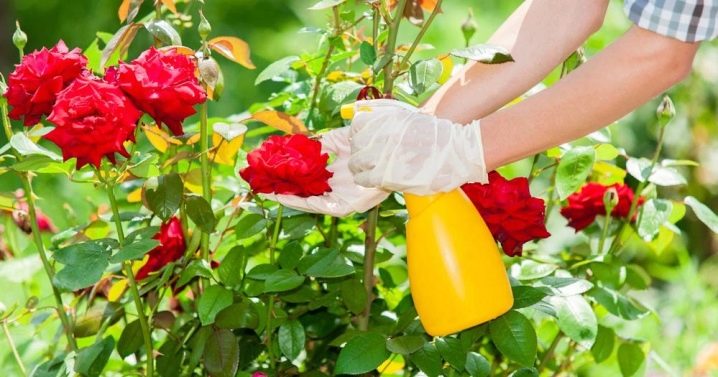
From June to September, roses should receive moisture once a week. As soon as the bush begins to bloom, pay attention to whether the flowers wither. If so, this is the first sign that the roses need more water. Newly planted roses need to be watered for the first time every other day. The best way to do this is water from a watering can, and if there are many plantings, then through a hose. It is best to water as close to the base of the bush as possible.If the water starts to flow out and does not get absorbed, it is worth stopping for a moment to allow the moisture to be absorbed, and then continue. Do not water the flowers or foliage, this can stimulate the appearance of diseases, especially if moisture remains on the leaves overnight.
Experts recommend a gentle spray rather than a powerful spray. If using a hose, it is best to install the fitting with a watering can.
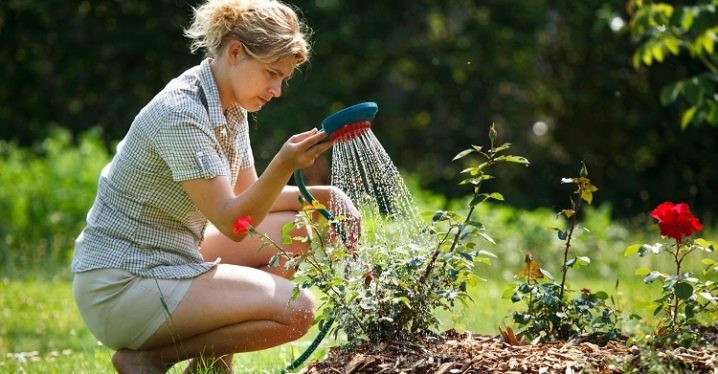
Disease and pest control
Most modern roses are selectively bred, therefore they have excellent resistance to pests and fungal diseases. However, there are some that need to be processed in order to protect. If a gardener has to deal with the problem of rose diseases, then most often these can be the three most common diseases.
- Black spot. Sometimes black spots appear on stems and leaves. Over time, diseased leaves will fall off, leaving the plant bare and sore. For processing, a copper-containing preparation is used in the spring. In addition, the grower needs to make sure that diseased branches and leaves are removed and those that have fallen to the ground are removed. If this is not done, the disease will spread further.
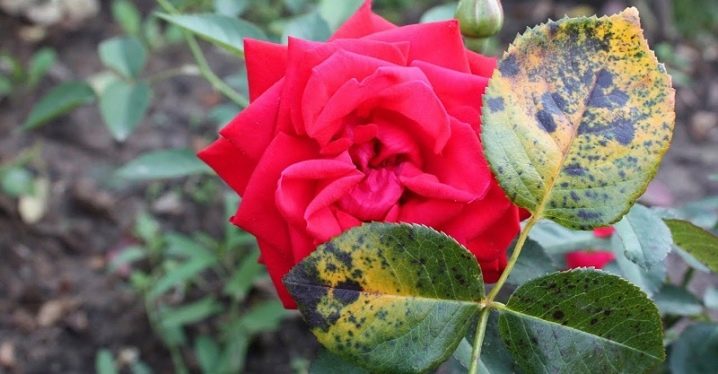
- Powdery Mildew. With this disease, white fluff appears on the foliage, less often it can be found on new buds. If left untreated, the disease will spread to the rest of the bush, killing all the foliage. Treat the plant with a mixture of baking soda, vegetable oil and water. For 1 gallon of liquid, take 3 parts of baking soda and 2 parts of oil. The mixture should be sprayed over the top and under the bush. Although already damaged leaves cannot be cured, it will help stop the spread of bacteria.
- Rust. The disease manifests itself as red spots on the lower part of the leaves. The best treatment is identical to what is used for black spot.
Rose bushes have many pests to deal with. For example, aphids, Japanese beetles, white flies are just a few of the most common. In most cases, these pests are easy to get rid of if they are identified immediately. Insecticidal soap is used as the main product.
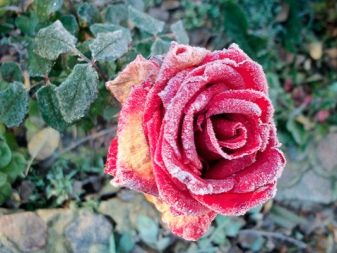
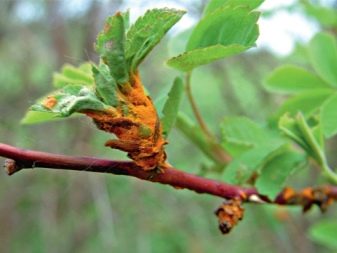
Pruning
Pruning is intimidating to some gardeners, but learning how to prune roses is not that difficult. The need for pruning has a number of reasons.
- Health. Dead or damaged branches must be harvested in late fall or early spring before the plant can resume growth. Sick processes are removed as soon as they are noticed so that the disease does not spread to the entire plant. What's more, pruning can improve air circulation by thinning the bush.
- Appearance. Bushy modern roses need help to maintain a compact, attractive shape.
- Control. Some varieties of roses grow very vigorously and pruning helps to contain the growth process.

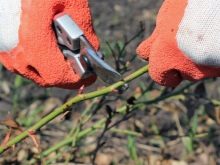
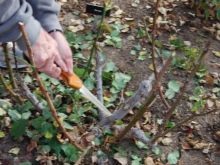
Pruning principles:
- always remove dead wood;
- cover the surface of each cut on the plant with a drop of glue to ensure quick recovery, as well as protection from diseases and pests;
- remove excess shoots on the main branch, which is not able to withstand a sufficiently thick second stem;
- remove growths from the root structure that grow from below;
- remove old woody twigs;
- after pruning is complete, remove leaves and old inflorescences from all over the bush.
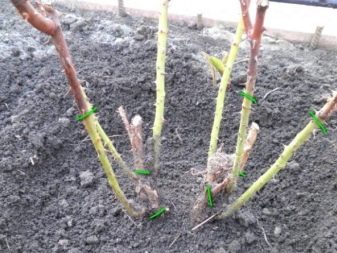

How to prepare for winter?
The main preparation of bushes for winter is pruning and covering, if necessary. The first should be done according to the principles described in the previous paragraph. As for covering, it is necessary for those varieties that are not included in the list of frost-resistant varieties. As a shelter, they use the earth, which is simply covered with a prepared and pruned bush, or old foliage. Sometimes covered with old blankets or other fabrics.
Top dressing for the winter is made in small quantities and at the discretion of the gardener himself.
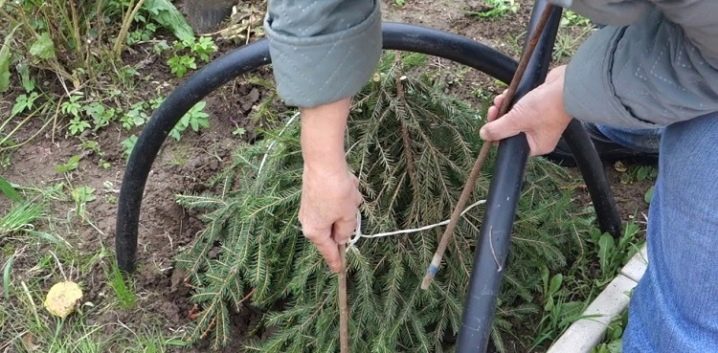
In the next video, a Greensad expert will tell you how to propagate a rose using cuttings.

































































































The comment was sent successfully.